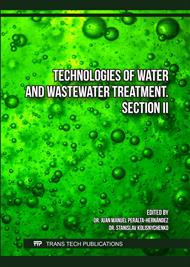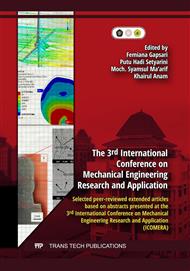[1]
D. P. Ordinartsev, N. V. Pechishcheva, S. Kh. Estemirova, A. V. Kim, and K. Yu. Shunyaev, 'Removal of Cr(VI) from wastewater by modified montmorillonite in combination with zero-valent iron', Hydrometallurgy, vol. 208, p.105813, Feb. 2022.
DOI: 10.1016/j.hydromet.2021.105813
Google Scholar
[2]
L. Fan et al., 'Adsorption Removal of Cr(VI) with Activated Carbon Prepared by Co-pyrolysis of Rice Straw and Sewage Sludge with ZnCl2 Activation', Water. Air. Soil Pollut., vol. 230, no. 10, p.233, Oct. 2019.
DOI: 10.1007/s11270-019-4305-8
Google Scholar
[3]
E. Vaiopoulou and P. Gikas, 'Effects of chromium on activated sludge and on the performance of wastewater treatment plants: A review', Water Res., vol. 46, no. 3, p.549–570, Mar. 2012.
DOI: 10.1016/j.watres.2011.11.024
Google Scholar
[4]
A. M. Sulaiman, S. Mas'ud, A. N. Daroini, and P. Purnami, 'THE EFFECT OF ELECTRODE COATING FROM BISPHENOL-A-POLYCARBONATE CD-R WASTE FOR HYDROGEN PRODUCTION', Int. J. Mech. Eng. Technol. Appl., vol. 4, no. 1, p.10–21, Jan. 2023.
DOI: 10.21776/MECHTA.2023.004.01.2
Google Scholar
[5]
E. I. Rhofita, R. Rachmat, M. Mayer, and L. Montastruc, 'An Energy Potential Estimation of Rice Residue in Indonesia: A Case Study in East Java', IOP Conf. Ser. Earth Environ. Sci., vol. 1024, no. 1, p.012029, May 2022.
DOI: 10.1088/1755-1315/1024/1/012029
Google Scholar
[6]
E. S. Elmolla, W. Hamdy, A. Kassem, and A. Abdel Hady, 'Comparison of different rice straw based adsorbents for chromium removal from aqueous solutions', Desalination Water Treat., vol. 57, no. 15, p.6991–6999, Mar. 2016.
DOI: 10.1080/19443994.2015.1015175
Google Scholar
[7]
X. Huang, X. Sheng, Y. Guo, Y. Sun, P. Fatehi, and H. Shi, 'Rice straw derived adsorbent for fast and efficient phosphate elimination from aqueous solution', Ind. Crops Prod., vol. 184, p.115105, Sep. 2022.
DOI: 10.1016/j.indcrop.2022.115105
Google Scholar
[8]
H. R. Robles-Jimarez et al., 'New silica based adsorbent material from rice straw and its in-flow application to nitrate reduction in waters: Process sustainability and scale-up possibilities', Sci. Total Environ., vol. 805, p.150317, Jan. 2022.
DOI: 10.1016/j.scitotenv.2021.150317
Google Scholar
[9]
A. K. Sakhiya, V. K. Vijay, and P. Kaushal, 'Efficacy of rice straw derived biochar for removal of Pb+2 and Zn+2 from aqueous: Adsorption, thermodynamic and cost analysis', Bioresour. Technol. Rep., vol. 17, p.100920, Feb. 2022.
DOI: 10.1016/j.biteb.2021.100920
Google Scholar
[10]
A. M. Adel, S. Kamel, and M. El-Sakhawy, 'Rice straw charcoal: Characterization and adsorption of Pb2+ from aqueous solution', Environ. Sci., p.10, 2013.
Google Scholar
[11]
Z. Chen, X. Xiao, B. Chen, and L. Zhu, 'Quantification of Chemical States, Dissociation Constants and Contents of Oxygen-containing Groups on the Surface of Biochars Produced at Different Temperatures', Environ. Sci. Technol., vol. 49, no. 1, p.309–317, Jan. 2015.
DOI: 10.1021/es5043468
Google Scholar
[12]
X. Xiao, B. Chen, and L. Zhu, 'Transformation, Morphology, and Dissolution of Silicon and Carbon in Rice Straw-Derived Biochars under Different Pyrolytic Temperatures', Environ. Sci. Technol., vol. 48, no. 6, p.3411–3419, Mar. 2014.
DOI: 10.1021/es405676h
Google Scholar
[13]
J. Zhou, H. Chen, R. W. Thring, and J. M. Arocena, 'Chemical Pretreatment of Rice Straw Biochar: Effect on Biochar Properties and Hexavalent Chromium Adsorption', Int. J. Environ. Res., vol. 13, no. 1, p.91–105, Feb. 2019.
DOI: 10.1007/s41742-018-0156-1
Google Scholar
[14]
E. Farahmand, 'Adsorption of Cerium (IV) from Aqueous Solutions Using Activated Carbon Developed from Rice Straw', Open J. Geol., vol. 06, no. 03, p.189–200, 2016.
DOI: 10.4236/ojg.2016.63017
Google Scholar
[15]
L. Fan et al., 'Adsorption Removal of Cr(VI) with Activated Carbon Prepared by Co-pyrolysis of Rice Straw and Sewage Sludge with ZnCl2 Activation', Water. Air. Soil Pollut., vol. 230, no. 10, p.233, Oct. 2019.
DOI: 10.1007/s11270-019-4305-8
Google Scholar
[16]
H. Gao, Y. Liu, G. Zeng, W. Xu, T. Li, and W. Xia, 'Characterization of Cr(VI) removal from aqueous solutions by a surplus agricultural waste—Rice straw', J. Hazard. Mater., vol. 150, no. 2, p.446–452, Jan. 2008.
DOI: 10.1016/j.jhazmat.2007.04.126
Google Scholar
[17]
H. Ma, J. Yang, X. Gao, Z. Liu, X. Liu, and Z. Xu, 'Removal of chromium (VI) from water by porous carbon derived from corn straw: Influencing factors, regeneration and mechanism', J. Hazard. Mater., vol. 369, p.550–560, May 2019.
DOI: 10.1016/j.jhazmat.2019.02.063
Google Scholar
[18]
Z. Wang, J. Wu, T. He, and J. Wu, 'Corn stalks char from fast pyrolysis as precursor material for preparation of activated carbon in fluidized bed reactor', Bioresour. Technol., vol. 167, p.551–554, Sep. 2014.
DOI: 10.1016/j.biortech.2014.05.123
Google Scholar
[19]
M. Zięzio, B. Charmas, K. Jedynak, M. Hawryluk, and K. Kucio, 'Preparation and characterization of activated carbons obtained from the waste materials impregnated with phosphoric acid(V)', Appl. Nanosci., vol. 10, no. 12, p.4703–4716, Dec. 2020.
DOI: 10.1007/s13204-020-01419-6
Google Scholar
[20]
V. Fierro, G. Muñiz, A. H. Basta, H. El-Saied, and A. Celzard, 'Rice straw as precursor of activated carbons: Activation with ortho-phosphoric acid', J. Hazard. Mater., vol. 181, no. 1–3, p.27–34, Sep. 2010.
DOI: 10.1016/j.jhazmat.2010.04.062
Google Scholar
[21]
S. Mashhadi et al., 'Rapid removal of Hg (II) from aqueous solution by rice straw activated carbon prepared by microwave-assisted H2SO4 activation: Kinetic, isotherm and thermodynamic studies', J. Mol. Liq., vol. 215, p.144–153, Mar. 2016.
DOI: 10.1016/j.molliq.2015.12.040
Google Scholar
[22]
W.-T. Tan, H. Zhou, S.-F. Tang, P. Zeng, J.-F. Gu, and B.-H. Liao, 'Enhancing Cd(II) adsorption on rice straw biochar by modification of iron and manganese oxides', Environ. Pollut., vol. 300, p.118899, May 2022.
DOI: 10.1016/j.envpol.2022.118899
Google Scholar
[23]
R. Kumar, D. K. Arya, N. Singh, and H. K. Vats, 'Removal of Cr (VI) Using Low Cost Activated Carbon Developed By Agricultural Waste', IOSR J. Appl. Chem., vol. 10, no. 01, p.76–79, Jan. 2017.
DOI: 10.9790/5736-1001017679
Google Scholar
[24]
C. A. Weemaes, V. Ooms, A. M. Van Loey, and M. E. Hendrickx, 'Kinetics of Chlorophyll Degradation and Color Loss in Heated Broccoli Juice', J. Agric. Food Chem., vol. 47, no. 6, p.2404–2409, Jun. 1999.
DOI: 10.1021/jf980663o
Google Scholar
[25]
M. J. Saad et al., 'Physical and Chemical Properties of the Rice Straw Activated Carbon Produced from Carbonization and KOH Activation Processes', Sains Malays., vol. 48, no. 2, p.385–391, Feb. 2019.
DOI: 10.17576/jsm-2019-4802-16
Google Scholar
[26]
T. Lin et al., 'Synergistic effect of iron doped ordered mesoporous carbon on adsorption-coupled reduction of hexavalent chromium and the relative mechanism study.', Chem. Eng. J., vol. 239, p.114–122, 2014.
DOI: 10.1016/j.cej.2013.10.104
Google Scholar
[27]
L. Anah and N. Astrini, 'Influence of pH on Cr(VI) ions removal from aqueous solutions using carboxymethyl cellulose-based hydrogel as adsorbent', IOP Conf. Ser. Earth Environ. Sci., vol. 60, p.012010, Mar. 2017.
DOI: 10.1088/1755-1315/60/1/012010
Google Scholar
[28]
J. Valentín-Reyes, R. B. García-Reyes, A. García-González, E. Soto-Regalado, and F. Cerino-Córdova, 'Adsorption mechanisms of hexavalent chromium from aqueous solutions on modified activated carbons', J. Environ. Manage., vol. 236, p.815–822, Apr. 2019.
DOI: 10.1016/j.jenvman.2019.02.014
Google Scholar
[29]
Ş. Parlayici and E. Pehlivan, 'Comparative study of Cr(VI) removal by bio-waste adsorbents: equilibrium, kinetics, and thermodynamic', J. Anal. Sci. Technol., vol. 10, no. 1, p.15, Dec. 2019.
DOI: 10.1186/s40543-019-0175-3
Google Scholar
[30]
H. P. Singh, P. Mahajan, S. Kaur, D. R. Batish, and R. K. Kohli, 'Chromium toxicity and tolerance in plants', Environ. Chem. Lett., vol. 11, no. 3, p.229–254, Sep. 2013.
DOI: 10.1007/s10311-013-0407-5
Google Scholar




